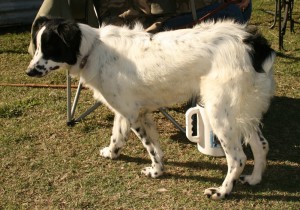
Dogs with excess white markings, sometimes referred to as mismarks, or over-marked. Australian Shepherds with too much white are usually healthy(exceptions noted below). There are entire breeds that allow far more white than typical of Aussies.
The breed standards limit the amount of white markings an Australian Shepherd is supposed to have. The Australian Shepherd Club of America standard says that areas around the eyes and ears should be “dominated” by non-white coloring and that a white collar should not extend beyond the point of the withers with “white body splashes” listed as a disqualification. The American Kennel Club standard is very specific: white is limited to locations on the neck (either in part or as a full collar), chest, legs, muzzle underparts, blaze on head and white extension from underpart up to four inches, measuring from a horizontal line at the elbow. White on the head should not predominate, and the eyes must be fully surrounded by color and pigment. The AKC standard disqualifies “White body splashes, which means white on body between withers and tail, on sides between elbows and back of hindquarters in all colors.”

These restrictions are not made just to produce a preferred look. Aussies with more than the allowed amount of white may have certain health and soundness issues. Offspring of two merle parents which have inherited two copies of the merle gene almost always have significant defects in eyesight and hearing and they almost always exhibit more white than is allowed by the standards. Dogs of any color that have a great deal of white on or around the ears may be deaf in one or both ears. Pink skin on the eye rims, nose, or muzzle is seen in dogs with excess white and may be subject to sun damage if the dog spends a lot of time outdoors in sunny environments,
If a non-merle dog has excess white and at least one of its parents is not merle, the cause is some combination of spotting genes, which determine the amount of white trim. Parents of these dogs are carrying the gene(s) that resulted in the unacceptable markings.
